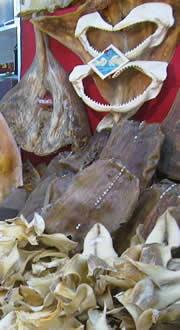 On the market: shark fins for sale.© Shelley Clarke
On the market: shark fins for sale.© Shelley ClarkeA conservative new estimate indicates that between 26 million and 73 million sharks are killed worldwide each year. That's three to four times higher than the numbers reported by the United Nations Food and Agriculture Organization.
Scientists have long suspected that the UN numbers were too low, thanks to a large chunk of illegal, unregulated or unreported trade in sharks. But data have been hard to come by.
"Numbers as high as 100 million had been floating around for a while, but we had no way of knowing whether or not this was accurate," says Ellen Pikitch, executive director of the University of Miami's Pew Institute for Ocean Science and an author on this week's paper in Ecology Letters1.
Fishy numbers
To get a better picture of the situation, Pikitch and her colleagues penetrated the auctions and black markets of Hong Kong and Taiwan, and arrived at the first fisheries-independent estimate, which reveals an annual trade in the tens of millions.
For centuries, well-heeled Chinese have enjoyed the delicacy of shark fin soup. The sharks' cartilaginous fins are used to make noodles, which are traditionally thought to bring long life to those who eat them.
Whole sharks often don't reach the ports where fishermen report their catches. Shark meat isn't considered valuable — its high urea content makes shark less appetizing than tender, flaky white fish. So fins are often removed and the shark carcasses simply tossed back into the water.
It is nearly impossible to identify the species caught from these dry, shrivelled fins; some are even mislabelled as something other than shark. "The only data that were available before were very sparse and very unreliable," says Pikitch.
Fin end of the wedge
So Pikitch and her colleagues, including lead author Shelley Clarke of the Joint Institute for Marine and Atmospheric Research in Shizuoka, Japan, painstakingly translated auction records of sold fin weights into estimates of shark numbers.
They also used DNA fingerprinting techniques on selected samples to identify the types of shark that were falling prey to the fishermen.
ADVERTISEMENT
A mathematical model was then used to estimate the magnitude of the total fin trade.
Although full population assessments cannot yet be made, the research suggests that for one commonly traded species, blue shark (Prionace glauca), the annual harvest of 10 million may be nearing or exceeding the sustainable yield. The species is currently listed as "lower risk" or "near threatened" by the World Conservation Union (IUCN).
Pikitch says that with the collapse of traditional whitefish markets, pressure on shark populations is increasing. "There's a growing use of sharks," she says. "We know they are being consumed in places where they were never consumed before."
Some 20% of shark species are threatened with extinction according to the IUCN's 2006 Red List of Threatened Species.
Visit our inhot_water.html">newsblog to read and post comments about this story.
